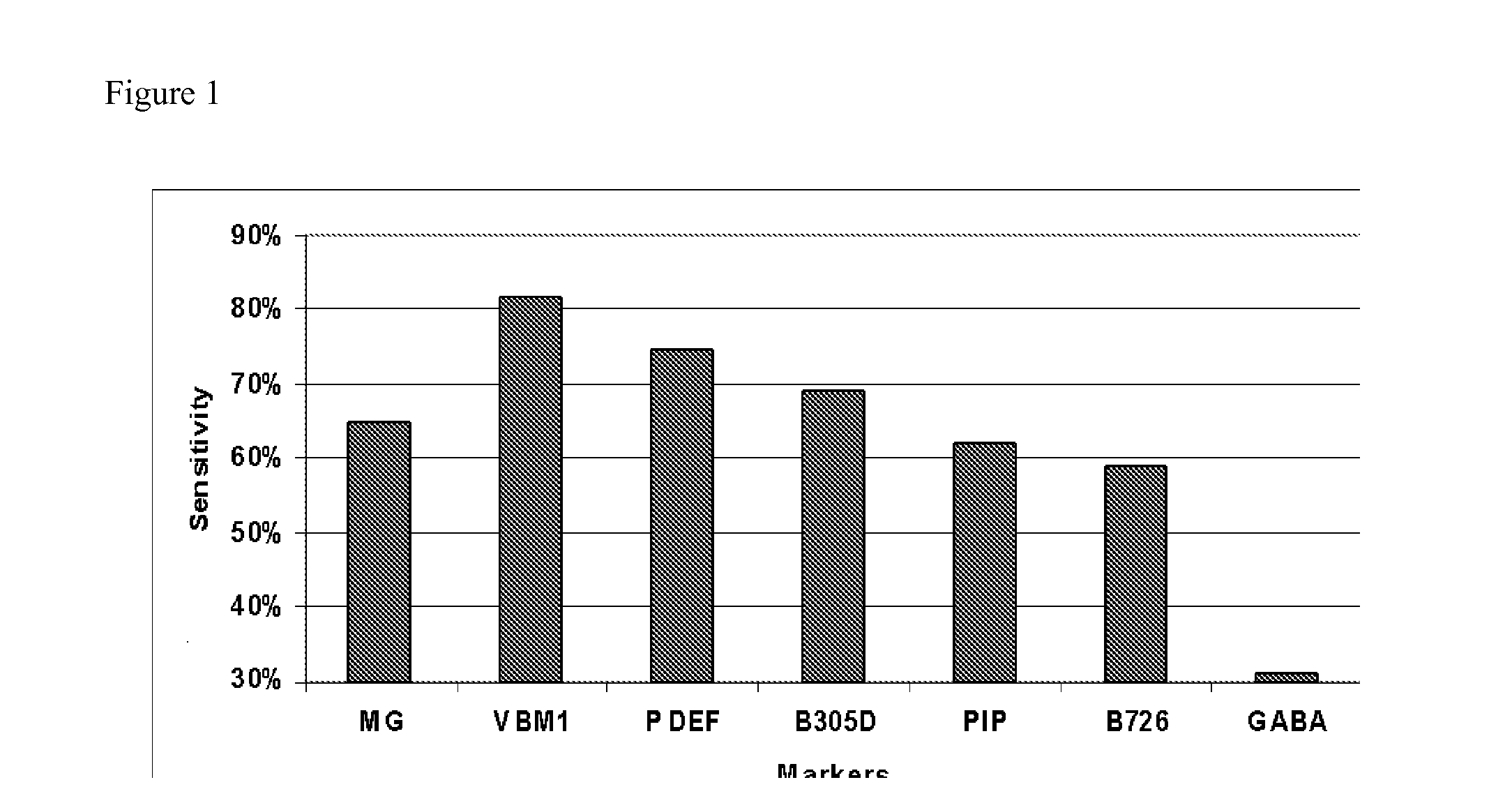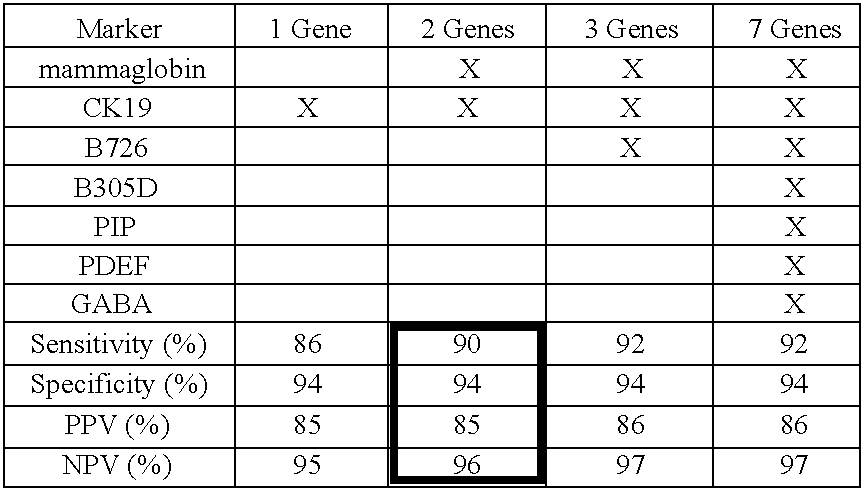Diagnosing or Predicting the Course of Breast Cancer
a breast cancer and cancer technology, applied in the field of molecular diagnostics, can solve the problems of combination of these methods, inability to rapidly be found, and large majority of the nodes left unexamined
- Summary
- Abstract
- Description
- Claims
- Application Information
AI Technical Summary
Benefits of technology
Problems solved by technology
Method used
Image
Examples
example 1
Two Gene Identification of Breast Cancer Cells in SLNs
[0049]The presence of axillary lymph node (ALN) metastasis is the most important prognostic factor for breast cancer patients. SLN status is highly predictive of overall ALN involvement. SLN-positive patients have historically undergone ALN dissection in a second surgery. Intraoperative SLN analysis methods have been implemented to reduce the cost and complications of second surgeries, but these methods suffer from poor and variable sensitivity and a lack of standardization. The following example shows the feasibility of RT-PCR as the basis for improving the intraoperative diagnosis of clinically relevant SLN metastasis.
[0050]Methods: Eight molecular markers, including mammaglobin, were identified from a genome-wide gene expression analysis of breast and other tissues. Alternate serial sections of SLN from 254 breast cancer patients were analyzed by permanent section H&E or quick frozen for RNA extraction. Blinded SLN cDNAs were ...
example 2
Optimal Primers and Probes for the Specific Detection of Mammaglobin, CK19 and PBGD mRNA
Mammaglobin Primers and Probes
[0061]The ability of Tth polymerase to provide adequate strand displacement and nuclease activities for a rapid assay was determined and primer and probes optimized for the appropriate assay conditions. The first set of primers / probes were specific for Exons 2 and 3. Experiments were conducted with and without Sybr Green to distinguish between successful amplification and detection. Optimization of divalent cation concentrations and addition of Magnesium (MgCl2) to Manganese (MnSO4) was performed to improve RT and amplification. One of these experiments also showed no significant difference between MnCl2 and MnSO4. These experiments lead to optimal assays utilizing two divalent cations—manganese (MnSO4) for RT and magnesium (MgCl2) for PCR at 2.5 mM and 3.5 mM respectively.
[0062]The first design generated a 105 bp amplicon and was redesigned in the same region to yie...
example 3
Rapid Assay Testing of Samples Purified by Standard Methods Samples
[0084]RNA was isolated from breast lymph nodes by a standard Trizol method. RNA was quantitated by absorbance at 260 nm. All RNAs were diluted to 200 ng / μl. RNA quality was determined by two-step RT-PCR using the housekeeping genes PBGD and β-actin. Samples were considered of adequate quality if both housekeeping genes gave signals within 3 cycles of the mean signal across all samples tested. The final set of samples tested represented 487 lymph node samples from 251 patients.
One-Step RT-PCR Testing
[0085]The RNA samples described above were amplified utilizing rapid, real-time, one-step RT-PCR containing primers and probes for mammaglobin (MG), keratin 19 (CK19) and PBGD. The primer and probe sequences utilized were as follows:
MG forward primer(SEQ ID NO: 9)AGTTGCTGATGGTCCTCATGCMG reverse primer(SEQ ID NO: 10)ATCACATTCTCCAATAAGGGGCAMG probe(SEQ ID NO: 11)Fam-CCCTCTCCCAGCACTGCTACGCA-BHQ1-TTCK19 forward primer(SEQ ID N...
PUM
| Property | Measurement | Unit |
|---|---|---|
| Fraction | aaaaa | aaaaa |
| Volume | aaaaa | aaaaa |
| Volume | aaaaa | aaaaa |
Abstract
Description
Claims
Application Information
 Login to View More
Login to View More - R&D
- Intellectual Property
- Life Sciences
- Materials
- Tech Scout
- Unparalleled Data Quality
- Higher Quality Content
- 60% Fewer Hallucinations
Browse by: Latest US Patents, China's latest patents, Technical Efficacy Thesaurus, Application Domain, Technology Topic, Popular Technical Reports.
© 2025 PatSnap. All rights reserved.Legal|Privacy policy|Modern Slavery Act Transparency Statement|Sitemap|About US| Contact US: help@patsnap.com


